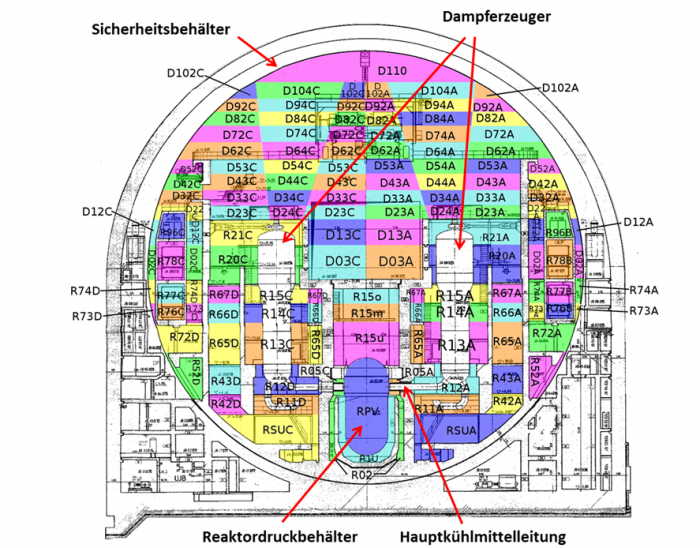COCOSYS
With its simulation code COCOSYS (COntainment COde SYStem), GRS is able to investigate the thermal hydraulic and chemical-physical processes inside the containment during incidents and accidents. In addition, COCOSYS can be used to determine the radioactive source term. This indicates the type and quantity of radioactive substances that may be released from a damaged containment into the environment. The determination of the source term including the time history of the release is important to be able to plan disaster control measures and to initiate them in case of an actual accident.
Code characteristics and structure
COCOSYS is a so-called 'lumped parameter code', i.e. a numerical simulation program in which the containment is divided into cells. For each of these cells, a defined thermodynamic state (temperature, pressure and gas composition) averaged over the cell is calculated (see image). Dynamic processes are represented by exchange processes between zones and between zones and structures (walls, floors, ceilings). This approach allows the simulation of events over several hours and days.
COCOSYS consists of three main modules:
- Thermal hydraulics: calculations of pressure and temperature, gas and steam flows, evaporation and condensation processes, and hydrogen and carbon monoxide combustion.
- Aerosol and fission products: calculations regarding chemical-physical processes, e.g. radioactive iodine in the atmosphere of the containment, deposition, aerosol leaching and filtering processes
- Melt-concrete interaction: calculation of, among other things, gas formation through thermochemical reaction of the melt with concrete.
There are specialised models running in the background of the modules in which the processes are largely simulated mechanistically.
One of the strengths of COCOSYS, apart from the diversity of the processes taken into account, is that the complex interactions - as far as they are known - are also simulated.
For some time now, the individual codes COCOSYS and ATHLET or ATHLET-CD (thermal hydraulics in the cooling system and core destruction) have been joined under the umbrella of the GRS code package AC2 and are increasingly used in combination. Thus, interactions and feedback effects between the cooling system and the containment during accident sequences can be simulated in even more detail and the behaviour of the plant during the entire accident sequence can be simulated.
Validation and application
Since the beginning of code development, COCOSYS has been extensively validated. This includes, in particular, successful pre- and post-calculations of experiments at test facilities in Germany and abroad. COCOSYS was also validated on the basis of the real core meltdown events at Fukushima. Furthermore, GRS regularly participates in national and international benchmark simulations (so-called code-to-code comparisons).
GRS has carried out numerous research activities with COCOSYS for different reactor designs. The results of this work have helped to widen the state of knowledge on accident sequences and to evaluate and improve concrete backfitting measures. One example is the arrangement of catalytic recombiners in the containment for the efficient recombination of hydrogen released during an accident. In addition, COCOSYS was used in international research projects to clarify and understand the accident sequence in Fukushima.
Numerous organisations at home and abroad use COCOSYS for reactor safety research.
But COCOSYS can also be used to investigate interesting questions outside the field of nuclear technology. For example, GRS uses COCOSYS to analyse the spread of the naturally occurring radioactive noble gas radon in buildings in order to derive targeted measures and recommendations for action to reduce the radon activity concentration. During the coronavirus pandemic, GRS investigated the behaviour of aerosols containing SARS-CoV-2 viruses in an exemplary indoor scenario. In doing so, it demonstrated the high significance of airborne virus-containing aerosols and quantitatively confirmed the effectiveness of ventilation measures and FFP2 facemasks.
